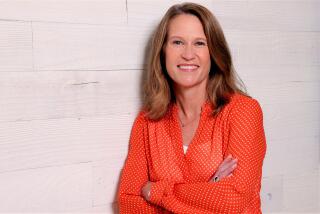Young Asian American skaters dream they can soar
Akari Nakahara wakes up at 4:30 a.m. six days a week. While most people are asleep, she races through breakfast before rushing off with her mother to an ice skating rink.
Once there, Akari will spend two hours stretching, spinning and soaring through the air like a ballerina on ice.
Only 7, Akari is one of a growing number of young Asian Americans who have fallen in love with figure skating and dream of becoming the next Michelle Kwan or Kristi Yamaguchi.
“She loves to skate,” said Akari’s mother, Kaori Nakahara, a piano teacher from Japan who recently began driving her daughter from their home in Santa Clarita to the Pasadena Ice Skating Center to train with her favorite coach. “I never have to wake her up in the mornings. She’s the one who tells me ‘Mommy, it’s time!’ ”
In recent years, Asian figure skaters from around the world have increasingly come to dominate the sport. The reigning Olympic women’s figure skating gold medalist is Shizuka Arakawa from Japan. Favored to succeed her is Kim Yu-na of South Korea.
Last week, at the Games in Vancouver, Chinese skaters Shen Xue and Zhao Hongbo broke a 48-year Russian winning streak to win the Olympic gold medal in the pairs competition.
Such success has inspired new generations of athletes and enthusiasts. Nowhere is this more apparent than at the Pasadena center.
“There has been sort of this boom in the last decade,” said Richard Wise, operations manager at the rink and a coach there since the early 1990s. “On any given day, the majority of the skaters here are Asian.”
The girls here have their own local role model in Mirai Nagasu, a 16-year-old skater from Arcadia who trained for years at the Pasadena rink and will be competing for the American team in Vancouver, starting Tuesday.
“I like her spins . . . and how when she smiles she makes me really happy,” said Karen Zhou, 11, whose mother is Japanese and father is Chinese.
Also from Arcadia, Karen began skating about two years ago after attending a friend’s birthday party at an ice rink.
“It was my first time skating,” said Karen, one of the more advanced skaters at the Pasadena center. Her favorite champions include Kim Yu-na and Mao Asada, a world champion from Japan.
“I met [Asada] once,” Karen said. “She was really graceful and her jumps were really big.”
Coach Victoria Stratton said those Asian girls who most often excel at the sport are short and slim, and lack “hips.” Those qualities, Stratton said, allow them to rotate quickly in the air. “You have to have no hips,” Stratton said. “You have to spin like a knife, not a spoon, to cut through the air.”
Peter Martell, of the Plano, Texas-based Ice Skating Institute, said the trend is not limited to Southern California. He said ice rinks across the nation are seeing greater numbers of Asian skaters.
“The Asian population in America has increased dramatically, and consequently there’s more Asian skaters,” Martell said.
But the sport is expensive, and the training can be demanding. A pair of custom-made skates can run $800 or more. Private lessons can cost up to $120 an hour. More advanced students require several coaches to focus on individual skills like spins and jumps.
“Every time you step on the ice you have to pay,” Stratton said. “To become a champion at a young age, you have to take lessons every day. You see what kind of money you run into.”
Susan Austin was Olympic hopeful Mirai Nagasu’s choreography coach between the ages of 5 and 13. She saw firsthand the commitment from her star pupil’s family, which ran a sushi restaurant in Arcadia.
“It’s pretty amazing, the dedication from her parents,” Austin said. “Her mother would close the sushi restaurant at 11 p.m. and be on the ice every morning at 5:30 or 6 a.m.”
For some parents, like Julie Yang, a doctor from Pasadena, skating is simply a fun alternative to other after-school activities for their kids.
“I was looking for a hobby for her, something that would keep her physically active,” said Yang as she watched her 5-year-old daughter Elizabeth glide across the ice with one foot in the air. “She started at 3 1/2 . It’s a big contributing factor to her confidence.”
Not all skaters here are female. Ethan Duong, 11, a Vietnamese American skater from Arcadia, started skating at age 7. He said getting up early to practice was not always easy.
“It takes a lot of endurance to not shut down the alarm clock,” he said.
But it was his mother, Tammy Thach, who almost gave up.
“I kept telling him, why don’t you stop, I’m cold,” said Thach, who sat bundled in a cold ringside seat while her son glided gracefully across the ice in a thin jump suit.
“I have to get up at 4 a.m. to get him ready, because he has to eat breakfast,” said the part-time insurance agent. “I kept saying, don’t go anymore. But he likes it.”
“Skating is fun. You get to experience something people don’t experience every day,” Ethan said. “You get to do different things on the ice and amaze people.”
One of Ethan’s inspirations is an even younger skater. Nathan Chen was only 10 when he won the men’s novice competition last month, landing triple jumps on the same ice where Nagasu had earned her spot on the Olympic team.
“I am several levels lower than him,” Ethan said. “Maybe I will catch up in a year if I work hard.”
More to Read
Go beyond the scoreboard
Get the latest on L.A.'s teams in the daily Sports Report newsletter.
You may occasionally receive promotional content from the Los Angeles Times.





